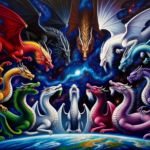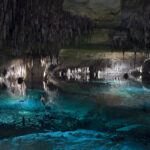Introduction
“Here be dragons” – these three words evoke a sense of mystery and adventure, harking back to an era when maps were as much a product of imagination as they were of exploration. While the phrase is now synonymous with uncharted territory and the unknown, its origins are shrouded in history and legend. In this article, we embark on a journey through time to uncover the fascinating story behind the phrase “here be dragons.”
Ancient Maps and the Age of Exploration
To understand the origins of “here be dragons,” we must first venture into the Age of Exploration, a period spanning the 15th to the 17th centuries. This was an age when intrepid explorers set sail in search of new trade routes, riches, and knowledge of the world. As they navigated uncharted waters, they meticulously documented their discoveries on maps.
Early maps, such as the Piri Reis map (1513) and the Cantino Planisphere (1502), are replete with illustrations of mythical creatures and warnings of dangerous sea monsters. These cartographic embellishments served both practical and symbolic purposes. On one hand, they cautioned mariners of potential hazards, like treacherous currents or shallow waters. On the other hand, they conveyed a sense of wonder and awe about the unexplored world, igniting the imaginations of those who studied these maps.
The First Appearance of “Here Be Dragons”
While many maps from this era feature fantastical creatures and inscriptions, the actual phrase “here be dragons” is believed to have first appeared on the Lenox Globe, also known as the Hunt-Lenox Globe, which dates back to the early 16th century. This small, copper globe, likely crafted in France, is one of the earliest surviving globes made of metal. It is adorned with Latin inscriptions, one of which reads “HC SVNT DRACONES,” which translates to “Here are dragons.”
The significance of this inscription remains a subject of debate among historians and cartographers. Some believe it was meant as a genuine warning about uncharted territories and the dangers they might hold, while others see it as a playful nod to the unknown, akin to the mythical creatures often depicted on maps of the time.
Dragons in Mythology and Cartography
Dragons have long been a symbol of the unknown and the fantastical in various cultures worldwide. In European mythology, dragons were often depicted as fierce, fire-breathing creatures guarding hidden treasures. In Chinese culture, dragons represented power, strength, and good fortune. By incorporating dragons on maps, cartographers tapped into a universally understood symbol that transcended language and culture.
The Evolution of Cartography
As time passed and the Age of Exploration gave way to more precise mapping techniques, the phrase “here be dragons” fell out of favor. Maps became increasingly accurate, and the focus shifted from the speculative to the empirical. The mysteries of the world were gradually unraveled, leaving little room for the fantastical creatures of old.
Conclusion
“Here be dragons” is a phrase that encapsulates an era of exploration, curiosity, and wonder. It reminds us of a time when maps were as much a product of imagination as they were of scientific observation. While its precise origin and meaning may remain somewhat elusive, the phrase endures as a powerful symbol of the human desire to venture into the unknown, to confront the mysterious, and to chart our world with both reason and wonder. In an age where most of the Earth’s secrets have been revealed, “here be dragons” stands as a testament to the spirit of exploration that continues to drive us to new frontiers, both on our planet and beyond.




